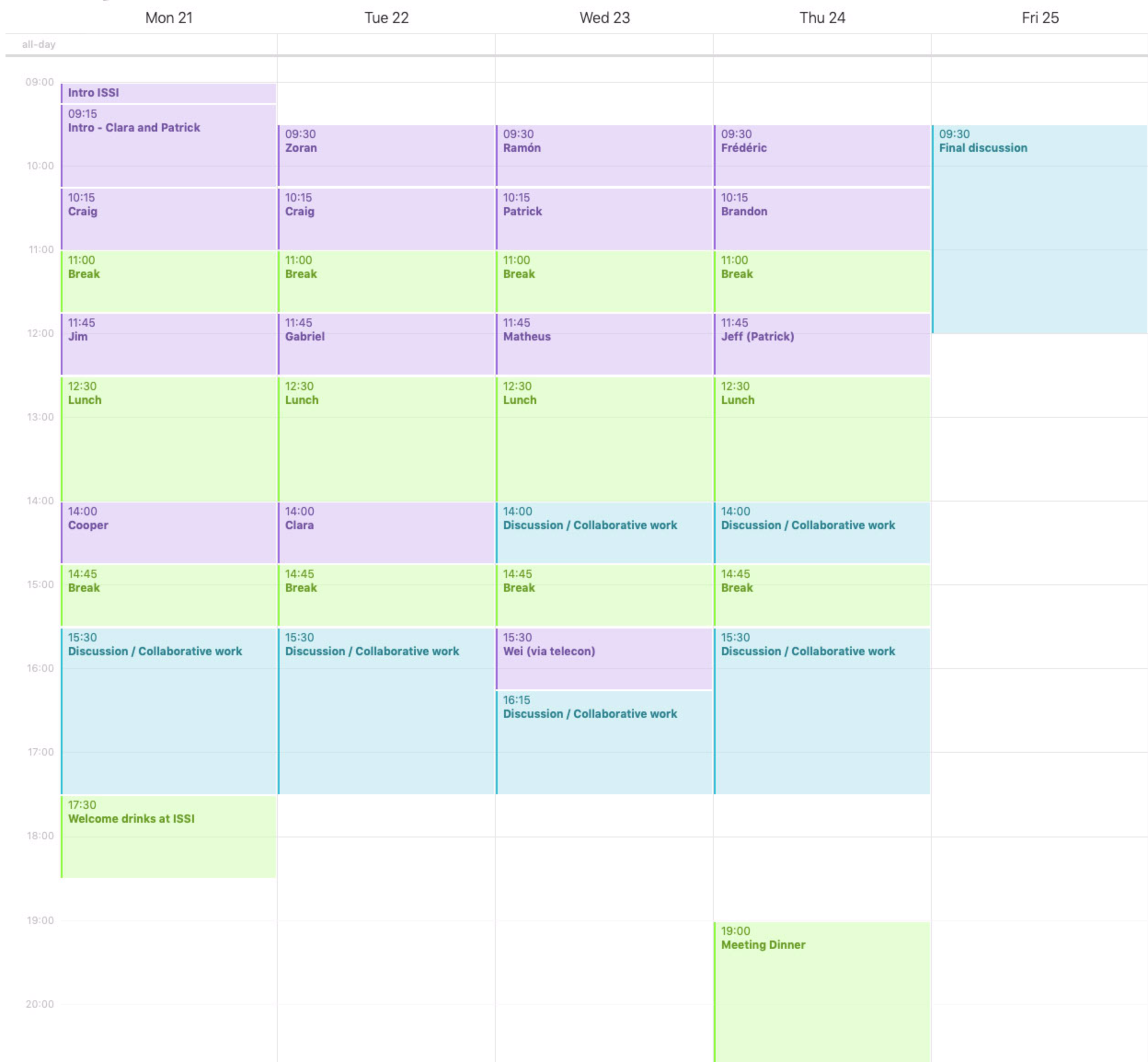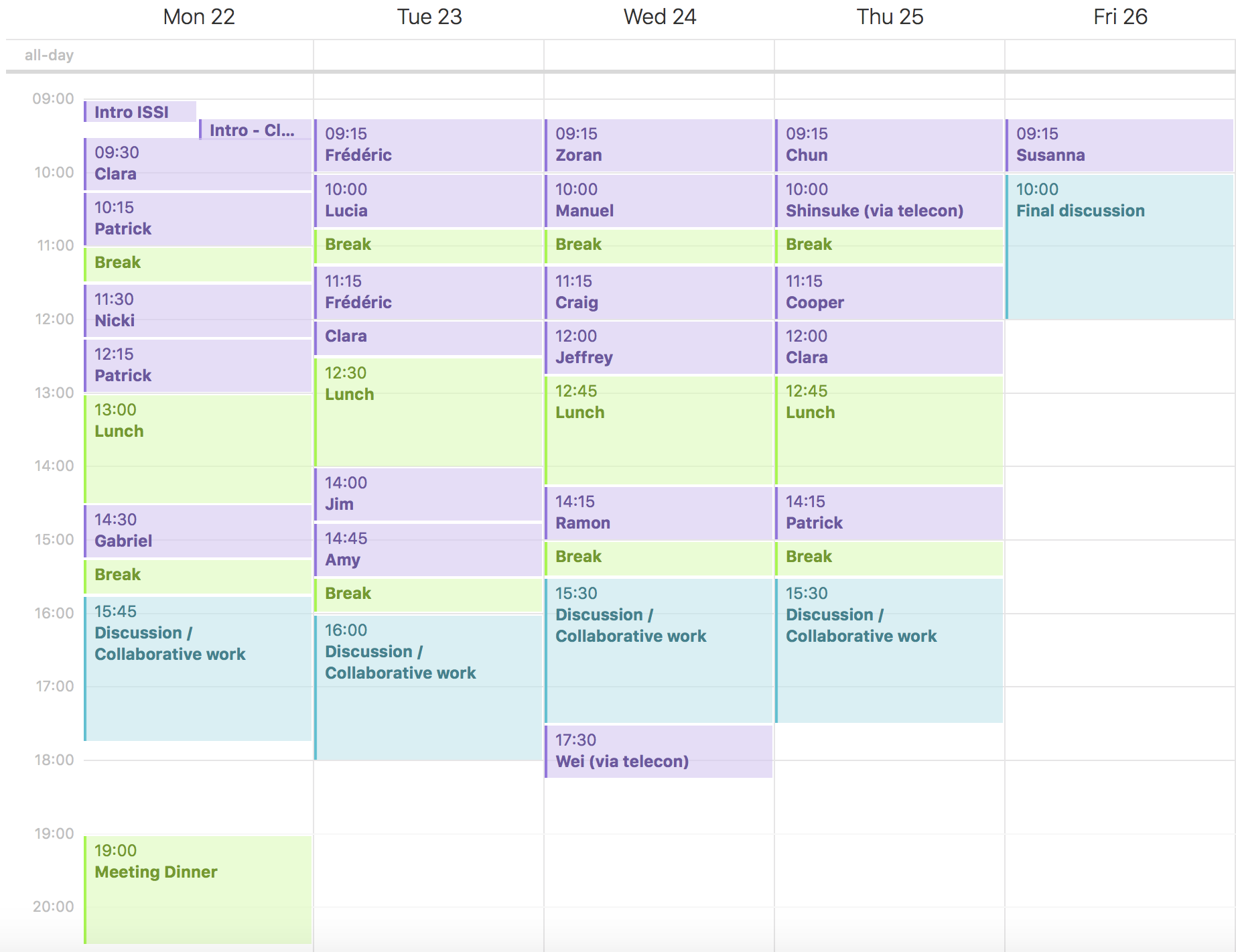The team met three times at the International Space Science Institute in Bern, Switzerland.
First team meeting: January 22nd to 26th, 2018
Second team meeting: January 21st to 25th, 2019
Third team meeting: October 29th to 31st, 2019
An extra 1-day meeting was held in St Andrews on June 10th, 2019 before the 9th Coronal Loops Workshop
Presentations from the third meeting (October 2019):
-
- Introduction to the meeting (Clara and Patrick)
- Thermal instability and Thermal non-equilibrium debate
-
- Thermal non-equilibrium and thermal instability in coronal loops (Patrick)
- Thermal instability and TNE (Ramón and Adel)
- The effects of numerical resolution and background heating on thermal non-equilibrium in coronal loops (Craig)
- A Fast and Accurate Method to Capture the Solar Corona/Transition Region Enthalpy Exchange (Craig)
- Diagnostics
-
- Coronal magnetic fields inferred from coronal rain spectropolarimetry (Matheus)
- On the use of the 171-131 and 171-304 for time lag maps (Clara)
- DEM, comparison observations/models (Clara)
- Unravelling flare-driven rain (Jeff, Patrick)
- Statistics pulsations & rain
-
- Automatic detection of coronal rain with AIA 304 (Patrick)
- What fraction of the coronal volume is undergoing TNE? (Frédéric)
- EMD (Clara)
————————————————————————————————————-
Presentations from the St Andrews meeting (June 2019):
- Simulations of the “coronal monsoon” event (Gabriel)
- Damping of large-amplitude longitudinal oscillations in prominences due to the evaporation-condensation process (Manuel)
- Electron beams cannot produce coronal rain (Jeffrey)
- Thermal instability-induced fundamental magnetic strands in coronal loops (Patrick)
- Coronal condensation at/near preferential topological features and its relationship with magnetic reconnection (Wei, via zoom)
- Observations of solar coronal rain in null point topologies (Nicki)
- Formation of coronal rain triggered by impulsive heating associated with magnetic reconnection (Clara, via zoom)
Presentations from the second meeting (January 2019):
Day 1 – Main variables affecting TNE cycles in the parameter space
- Modelling the Transition Region Using an Adaptive Conduction Method (Craig)
- Thermal non-Equilibrium in 1D and 3D: Quantifying Cycle Properties and Testing Predictions (Cooper)
- Test of analytical predictions with a parameter-space study (Clara)
Day 2: Simulations and influence of the setup and modelling of the transition region – Character of the thermal instability in TNE cycles (complete vs incomplete, detection of flows)
- Exploration of Heating of AR11339 (November 8, 2011) (Zoran)
- Modelling the Transition Region & Thermal Non-Equilibrium in Coronal Loop Models (Craig)
- On the detection of plasma flows associated with incomplete-condensation cycles (Gabriel)
- Multi-scale observations of TNE (Clara)
Day 3: Coronal rain, magnetic field and heating mechanisms
- Coronal rain dynamics from 2D numerical simulations (Ramón)
- Magnetic field determination using the Weak Field Approximation (Matheus)
- Magnetic Topological Preference in Coronal Condensation (from prominence/coronal rain) (Wei, via telecon)
Day 4: Loop modelling, coronal rain and solar flares
- 3D reconstruction of the loops bundle channeling coronal rain during the “Rainbow” event (Frédéric)
- Machine learning for tracking flows (Brandon)
- Electron beams cannot produce coronal rain (Jeff via Patrick)
————————————————————————————————————–
Presentations from the first meeting (January 2018):
I – Observations of evaporation-condensations in the solar atmosphere
Main topics for the presentation and discussions :
– Thermal non-equilibrium events (cycles) and coronal rain
– Study of flows associated with pulsations in loops
– Prominence connection
– Detection of EUV pulsations and coronal rain, what fraction of the coronal volume experiences these events?
- Observations of cooling in EUV lines and cooling/heating cycles in loops – review (Clara)
- High resolution observations of coronal rain – review (Patrick)
- Thermal non-equilibrium observed/modeled/measured with time lag analysis in prominences (Nicki)
- Analysis of the spatio-temporal correlation in the IRIS & AIA intensity evolution for a rainy loop oscillating with transverse MHD waves (Patrick)
- On the detection of velocities associated with TNE events in EIS data (Gabriel)
- Detection of supersonic events with IRIS spectra & machine learning (Lucia)
- Detection of periodic pulsation events (Frédéric)
- Detection of periodic coronal rain: The “Rain bow” (Frédéric)
- Database of periodic events (Clara)
- Quick timelag analysis of “running window” data (Amy)
- Prominence – coronal rain connection, and/or flare rain in some recent events (Wei, online from LMSAL)
II – Numerical models
Main topics for the presentation and discussions :
– 1D and multi-dimensional modeling
– Formation and dynamics of coronal rain
– Large scale simulations (active regions) of thermal non-equilibrium events
- When Do Asymmetries Prevent Thermal Non-Equilibrium from Occurring (Jim)
- Large scale parameter space study for discriminating observations between TNE and impulsive heating (Amy)
- 1D modeling of thermal non-equilibrium (Zoran)
- Common origin of coronal rain and solar prominences (Manuel)
- Effect on TNE cycles of the background heating and the spatial resolution in the transition region (Craig)
- Modeling of coronal rain, flare-associated coronal rain issue (Jeffrey)
- Dynamics of coronal rain blobs (Ramon)
- Multi-dimensional simulations of coronal rain and prominences (Chun)
- Discussion on the origin of the continuous evaporation-condensation cycle oscillation in coronal loops (Shinsuke, online from Nagoya)
- Simulation of LOS integrated 1D loops (Cooper)
- The occurrence of TNE cycles in active regions (Clara)
- Influence of stochasticity on TNE cycles (Patrick)
- Co-obs SOHO/SUMER and long-period intensity pulsations on disk (Susanna)


